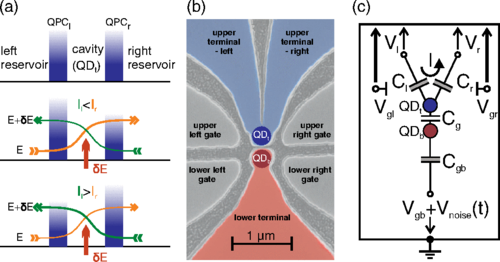April 13, 2015 report
Researchers find a way to convert waste heat to electricity at nano-scale

(Phys.org)—A team of researchers working at Germany's University of Würzburg has shown that a theory developed to describe a way to convert waste heat in microelectronics to electricity can work in the real world. In their paper published in the journal Physical Review Letters, the team describes how they used quantum dots to create a three terminal device capable of generating electricity by harvesting waste heat.
As microelectronics have grown smaller, the problem of waste heat has grown bigger—not only does excess heat create problems for system components, it also represents wasted energy. If that heat could be converted to electricity and used to help run devices, it would allow them to run longer while using less battery power. In this new effort, the team working in Germany reports on experiments they conducted using quantum dots—and idea proposed four years ago by a team working at the University of Geneva—they envisioned using quantum dots to construct a three terminal device that would allow an electrical charge generated from a heat difference to pass from one terminal to another without allowing the heat to transfer as well. In their lab, they built a rectifier (a device that converts AC current to DC) based on two types of quantum dots, one made of gallium arsenide, the other aluminum gallium arsenide. One of the dots was affixed to an electric circuit, which provided alternating current in the form of voltage fluctuations—the other dot served as the receiver allowing direct current to flow out.
It should be noted that the researchers have not actually converted waste heat to electricity, instead they have used voltage fluctuations from a voltage source to mimic the process, which they claim, proves the original idea could work. They were forced to take this route because the technology does not yet exist to measure the differences between the two dots accurately. The next step will be to modify the device to convert the waste heat directly to electricity and then to figure out a way to measure the results. The team appears confident their approach will work and predict such devices will soon make their way into actual products.
More information: Voltage Fluctuation to Current Converter with Coulomb-Coupled Quantum Dots, Phys. Rev. Lett. 114, 146805 – Published 10 April 2015. DOI: 10.1103/PhysRevLett.114.146805
ABSTRACT
We study the rectification of voltage fluctuations in a system consisting of two Coulomb-coupled quantum dots. The first quantum dot is connected to a reservoir where voltage fluctuations are supplied and the second one is attached to two separate leads via asymmetric and energy-dependent transport barriers. We observe a rectified output current through the second quantum dot depending quadratically on the noise amplitude supplied to the other Coulomb-coupled quantum dot. The current magnitude and direction can be switched by external gates, and maximum output currents are found in the nA region. The rectification delivers output powers in the pW region. Future devices derived from our sample may be applied for energy harvesting on the nanoscale beneficial for autonomous and energy-efficient electronic applications.
Journal information: Physical Review Letters
© 2015 Phys.org



















